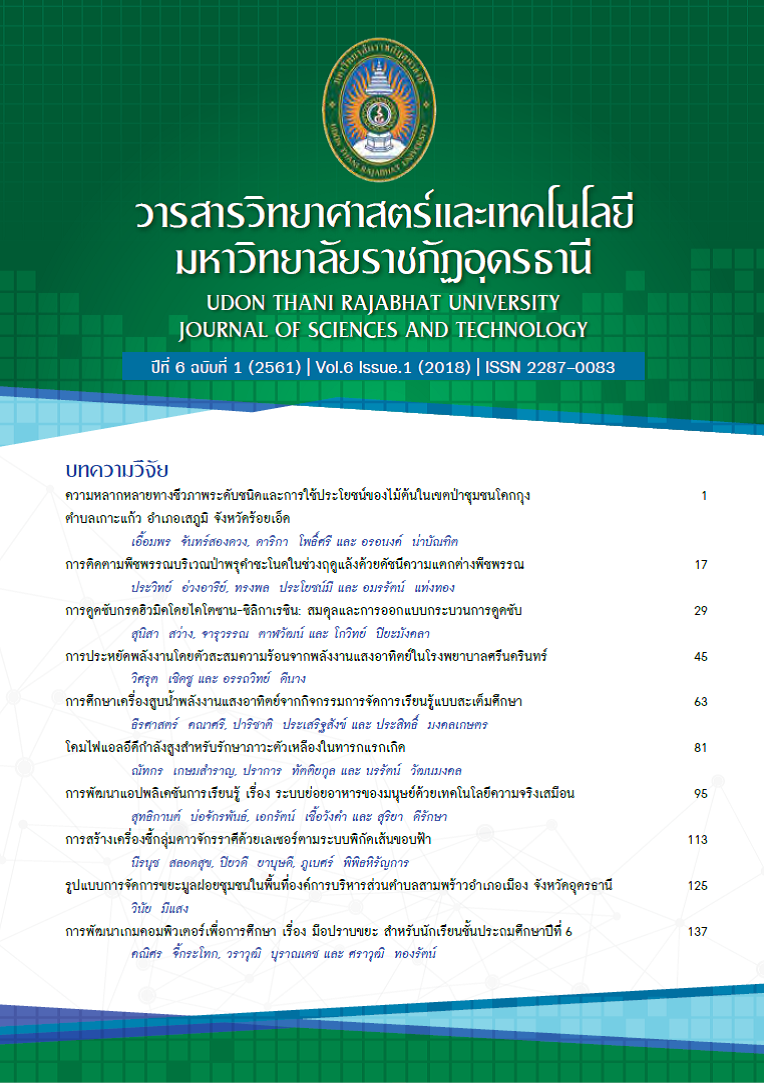รูปแบบการจัดการขยะมูลฝอยชุมชนในพื้นที่องค์การบริหารส่วนตำบลสามพร้าว อำเภอเมือง จังหวัดอุดรธานี
Main Article Content
บทคัดย่อ
การศึกษานี้มีวัตถุประสงค์เพื่อศึกษารูปแบบการจัดการขยะมูลฝอยชุมชนในพื้นที่องค์การบริหารส่วนตำบลสามพร้าว อำเภอเมือง จังหวัดอุดรธานี โดยแบ่งออกเป็น 2 ส่วน ได้แก่ ส่วนที่ 1 การศึกษาองค์ประกอบ ปริมาณ อัตราการเกิด ความหนาแน่น การคาดการณ์ ของขยะมูลฝอยชุมชน ส่วนที่ 2 การศึกษาระดับความพึงพอใจและความรู้ความเข้าใจในการจัดการขยะมูลฝอยของประชาชน ผลการศึกษาพบว่าปริมาณขยะมูลฝอยที่เกิดขึ้นต่อวันขององค์การบริหารส่วนตำบลสามพร้าวอยู่ที่ 0.38 กิโลกรัมต่อคนต่อวัน ความหนาแน่นของขยะมูลฝอยอยู่ที่ 14.60 ลูกบาศก์เมตร องค์ประกอบของขยะมูลฝอย ขยะทั่วไป ขยะอินทรีย์ ขยะรีไซเคิล และขยะอันตรายคิดเป็นร้อยละ 33.34, 38.11, 25.19 และ 2.50 ตามลำดับ จากการคาดการณ์ปริมาณขยะมูลฝอยในอีก 5, 10, 15, 20 และ 25 ปี พบว่าการเพิ่มขึ้นของปริมาณขยะมูลฝอยอยู่ที่ 5.25, 11.27, 15.14, 18.71 และ 23.50 กิโลกรัมต่อคนต่อวันตามลำดับ ส่วนที่ 2 การศึกษาระดับความพึงพอใจและความรู้ความเข้าใจในการจัดการขยะมูลฝอย โดยใช้แบบสอบถามในการเก็บข้อมูลจากประชากรทั้งหมด 18,339 คน ใช้วิธีการสุ่มตัวอย่าง (sample random sampling) 770 คน ผลการศึกษาพบระดับความพึงพอใจและความรู้ความเข้าใจในการจัดการขยะมูลฝอย ทัศนคติเกี่ยวกับการจัดการขยะมูลฝอยชุมชน ความเต็มใจในการมีส่วนร่วมจัดการขยะมูลฝอยชุมชนและความเต็มใจในการมีส่วนร่วมเมื่อมีปัจจัยสนับสนุนมีนัยสำคัญทางสถิติ (p<0.05) รูปแบบที่เหมาะสมในการจัดการขยะมูลฝอยขององค์การบริหารส่วนตำบลสามพร้าว ตำบลสามพร้าว อำเภอเมือง จังหวัดอุดรธานี ควรจัดทำปุ๋ยหมักภายในครัวเรือน การตั้งศูนย์คัดแยกขยะภายในชุมชนพบปริมาณขยะอินทรีย์มากกว่าขยะประเภทอื่น
Article Details
References
กรมควบคุมมลพิษ. (2556). ปริมาณการเกิดขยะมูลฝอยในประเทศไทยและจำนวนประชากร ปี พ.ศ. 2559. กรุงเทพฯ: กระทรวงทรัพยากรธรรมชาติและสิ่งแวดล้อม.
จิตรตี มณีไสย์ และ พัฒนา อนุรักษ์พงศธร. (2553). ปริมาณและองค์ประกอบของขยะมูลฝอย เพื่อเป็นแนวทางการจัดการขยะมูลฝอยในพื้นที่อุทยานแห่งชาติน้ำตกเจ็ดสาวน้อย จังหวัดสระบุรี. กรุงเทพฯ: สำนักงานกองทุนสนับสนุนการวิจัย.
นนทวรณ อินทรวรรณ และคณะ. (2559). การพัฒนาระบบการจัดการขยะมูลฝอยในเทศบาลตำบลแม่ยาว จังหวัดเชียงใหม่. เอกสารประกอบการประชุมวิชาการระดับชาตินเรศวรวิจัย ครั้งที่ 12, 603-613.
พิภัทร แสงสินชุศร. (2550). พฤติกรมการจัดการขยะมูลฝอยของประชาชนเขตเทศบาลนครภูเก็ต จังหวัดภูเก็ต. (วิทยานิพนธ์ปริญญาศาสนศาสตรมหาบัณฑิต, มหาวิทยาลัยบูรพา).
ไพบูลย์ แจ่มพงษ์. (2555). การใช้ประโยชน์และการจัดการขยะมูลฝอยของครัวเรือนประชาชน ตำบลสวนหลวง อำเภออัมพวา จังหวัดสมุทรสงคราม. กรุงเทพฯ: มหาวิทยาลัยราชภัฏสวนสุนันทา.
วิทยา ยนต์สันเทียะ. (2557). รูปแบบและวิธีการกำจัดขยะที่เหมาะสมกับพื้นที่องค์การบริหารส่วนตำบลหนองบุนนาก อำเภอเมืองบุญนาก จังหวัดนครราชสีมา. (วิทยานิพนธ์ปริญญาวิศวกรรมศาสตรมหาบัณฑิต, มหาวิทยาลัยเทคโนโลยีสุรนารี).
วินัย มีแสง. (2559). แนวโน้มองค์ประกอบและปริมาณการเกิดขยะมูลฝอยชุมชนในพื้นที่ตำบลสามพร้าว อำเภอเมือง จังหวัดอุดรธานี. วารสารสมาคมนักวิจัย, 21(3), 214.
สรศักดิ์ ชุมแวงวาปี. (2556). การศึกษาทางเลือกระบบการกำจัดมูลฝอยที่เหมาะสมกับพื้นที่เทศบาลตำบลเขื่อนอุบลรัตน์ อ.อุบลรัตน์ จ.ขอนแก่น. (วิทยานิพนธ์ปริญญาวิศวกรรมศาสตร์มหาบัณฑิต, มหาวิทยาลัยเทคโนโลยีสุรนารี).
องค์การบริหารส่วนตำบลสามพร้าว. (2558). จำนวนประชากรในองค์การบริหารส่วนตำบลสามพร้าว อำเภอเมือง จังหวัดอุดรธานี. อุดรธานี: องค์การบริหารส่วนตำบลฯ.

